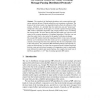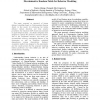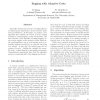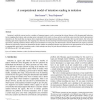441 search results - page 35 / 89 » A Method for Proving Observational Equivalence |
FORTE
2010
13 years 10 months ago
2010
Abstract. The complexity of distributed algorithms, such as state machine replication, motivates the use of formal methods to assist correctness verification. The design of the for...
CORR
2006
Springer
13 years 9 months ago
2006
Springer
We consider transmission over the ergodic fading multiple-antenna broadcast (MIMO-BC) channel with partial channel state information at the transmitter and full information at the ...
CSIE
2009
IEEE
14 years 3 months ago
2009
IEEE
This paper proposed an approach of human behavior modeling based on Discriminative Random Fields. In this model, by introducing the hidden behavior feature functions and time wind...
ICDM
2005
IEEE
14 years 2 months ago
2005
IEEE
Ensemble methods have proved to be highly effective in improving the performance of base learners under most circumstances. In this paper, we propose a new algorithm that combine...
RAS
2006
13 years 8 months ago
2006
Imitation in artificial systems involves a number of important aspects, such as extracting the relevant features of the demonstrated behaviour, inverse mapping observations, and e...




